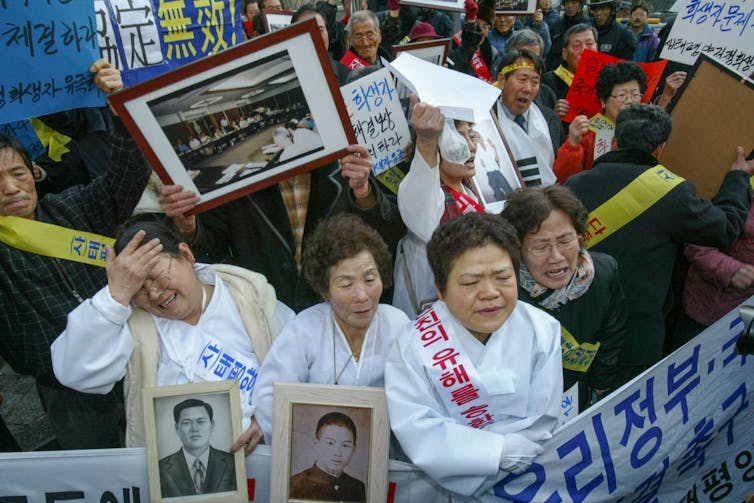Disinformation targeting Brigitte Macron spreads beyond France
Paris (AFP) – Years after false posts began circulating on social media purporting Brigitte Macron is a transgender woman, the French first lady remains the target of fake claims with the transphobic disinformation spreading to the United States.
THE TRANSGENDER SLANDER BY RIGHT WING INCELS BEGAN WITH MICHELLE OBAMA, THEN HILLARY IN 2016, BEFORE THE CURRENT RIGHT WING GOP ATTACK ON TRANSGENDER PEOPLE AND THEIR HUMAN RIGHTS IN THE U$
Issued on: 29/03/2024 - 
The French president's wife Brigitte Macron is taking legal action over the claims
© JULIEN DE ROSA / AFP
President Emmanuel Macron, 46, has in recent weeks lashed out at the false information spread about his wife, 70, who is taking legal action against those behind the allegations.
Prominent US conservative commentator Candace Owens vehemently attacked the first lady in a now-deleted YouTube video posted on March 11, propagating a false claim that first exploded in France just weeks before the 2022 presidential election.
Brigitte Macron is falsely accused of being born as a man called Jean-Michel Trogneux, her maiden surname, with that name going viral as a hashtag.
Macron is among a group of influential women -- including former US first lady Michelle Obama and New Zealand ex-premier Jacinda Ardern -- who have fallen victim to a growing trend: disinformation about their gender or sexuality to mock or humiliate them.
While this gendered disinformation is particularly visible in repeated attacks on prominent figures, it also affects women in general and sexual or gender minorities with differing levels of responsibility in public life.
According to the US-based observer group, the National Democratic Institute (NDI), the goal is to drive women "off the platforms and out of public life", which has serious consequences for democracy.
- 'Across the Atlantic' -
Originally shared in the United States on sites like notorious disinformation hub 4chan, the claim snowballed when figures "with very large audiences gave it visibility", doctoral researcher Sophie Chauvet, specialising in audience metrics, told AFP.
In her video, conservative commentator Owens cites a "thorough investigation" by so-called independent journalist Natacha Rey, published in the French newsletter Faits et Documents in 2021.
Founded in 1996 by far-right French figure Emmanuel Ratier and now headed by Xavier Poussard, Faits et Documents regularly promotes stories targeting the first lady, a journalist at the French weekly L'Obs, Emmanuelle Anizon, told AFP.
"But what is new is that Xavier Poussard started translating his articles at the end of 2023," Anizon said, adding that he claims to have sent an English version to those close to former US president Donald Trump.
Anizon, who spoke to Poussard and his associate Aurelien Poirson who advised on the translation, explained that it was no accident that the US far right had taken up the false claim ahead of the November US elections.
"It was their dream to export this rumour across the Atlantic," she said.
And it worked, spreading like wildfire after Owens posted her video with two associated hashtags shared tens of thousands of times on X, according to social network analysis tool Visibrain.
The rumour "was available as and when required", said Sebastian Dieguez, an expert in conspiracy theories at the University of Fribourg in Switzerland.
The "secretly trans" narrative is a long-standing feature of online, sexist violence, according to a 2021 Wilson Center report.
The bottom line, according to the NDI, is that silencing women has "serious consequences for human rights, diversity in public debates and the media, and ultimately, democracy."
'Grotesque' rumours
The impact is also personal for those targeted and their families.
Emmanuel Macron addressed the rumours on International Women's Day, saying, "the worst thing is false information".
"People eventually believe them and disturb you, even in your private life," he said.
The president's relationship with his wife 24 years his senior, whom he met while she was a teacher and he was still a teenager, is periodically a source of media attention in France and abroad.
There has long been curiosity about the private life of the Macrons
© JULIEN DE ROSA / AFP
On March 22, a 51-year-old man was arrested in southwestern France for allegedly writing "Brigitte Macron, transsexual" on his garage, according to the French daily Le Figaro.
The first lady and her brother Jean-Michel Trogneux have taken legal action against two women who posted a Youtube video in December 2021 alleging she had once been a man named "Jean-Michel".
A Paris criminal court is to try them on charges of defamation in March next year, a source close to the case has said.
The first lady's daughter from her first marriage, Tiphaine Auziere, on Tuesday said she hoped the trial could quash the "grotesque" rumours.
"Whether it's my mother or anyone else in society, it can do a lot of harm," Auziere told the BFMTV broadcaster.
"The justice system... can put an end to this misinformation and severely condemn the perpetrators because it's a form of harassment like any other."
© 2024 AFP


 Lee loves 'sitting down with paper and a pencil', a feeling AI cannot replicate © JULIEN DE ROSA / AFP
Lee loves 'sitting down with paper and a pencil', a feeling AI cannot replicate © JULIEN DE ROSA / AFP























